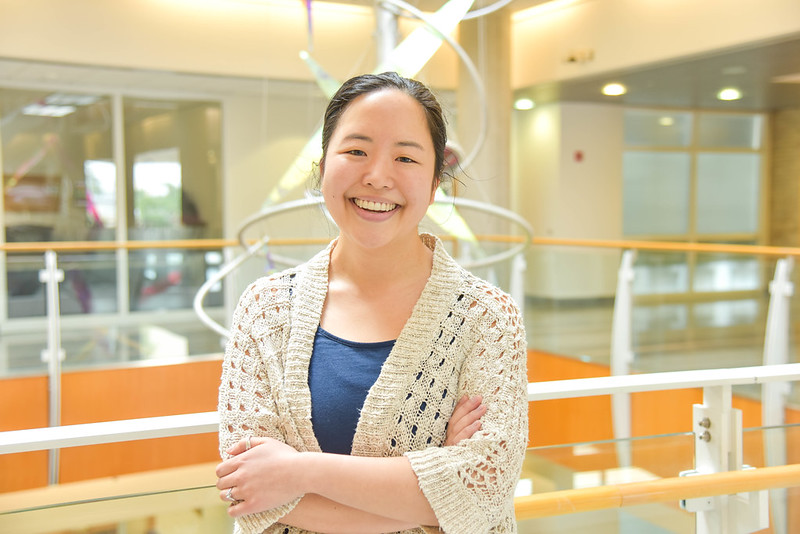Published on
Increasing detection of reinfections and rediscovering brand new infections within days raises concerns for herd immunity and the durability of vaccine efficacy.

Cynthia Tang working to figure out how COVID-19 reinfections can bring us answers on how the virus is developing at Bond LSC. | photo by Davis Suppes, Bond LSC
By Davis Suppes | Bond LSC
Like many viruses, SARS-CoV-2 continues to develop and evolve with time. As the virus evolves it can become more infectious, produce worse symptoms, and have a higher fatality rate. While people receive more treatment for this virus we also learn more about it, including how different variations of the same virus can reinfect someone who already had SARS-CoV-2 and beat it.
In a recent study led by Cynthia Tang, an MD-PhD student at the University of Missouri Institute for Data Science and Informatics, was able to identify a patient who got reinfected with a different strain of SARS-CoV-2 just 19 days after their initial infection. Her lab is the Center for Influenza and Emerging infectious Diseases and is headed by Principal Investigator Dr. Henry Wan.
“We have found a case of reinfection that occurred during a shorter window of time than what we see in the current US Centers for Disease Control and Prevention (CDC) guidelines,” Tang said, “so we may be missing a subset of those reinfection cases.”
In October 2020, the CDC published investigative criteria for suspected SARS-CoV-2 reinfections. These criteria included: any individuals testing positive over 90 days after their first laboratory-confirmed SARS-CoV-2 infection, or symptomatic individuals testing positive 45–89 days after initial infection with paired respiratory specimens.
For this patient, nineteen days following her initial positive test in March of 2020, she returned for another SARS-CoV-2 test due to return-to-work requirements. Despite her symptoms fading to encompass only productive cough and fatigue she tested positive again. She continued to experience persistent cough, fatigue, and difficulty breathing until 55 days after her initial positive test.
Phylogenetic analyses showed that the two samples contained SARS-CoV-2 viruses from two distinct lineages. Additionally, they compared the sequences between viral isolates and clinical samples. Results showed that sequences from each isolate were identical to the corresponding clinical sample, but those at the first sample and at the second sample were distinct.
No diverse polymorphisms, or a mixture of different viruses, were identified among the sequences of the viruses from each clinical sample, suggesting true reinfection rather than a coinfection.
The CDC has encouraged symptom-based strategies for ending isolation rather than viral retesting for asymptomatic individuals or for individuals without new symptoms during 90 days after illness onset due to findings that detectable but noninfectious SARS-CoV-2 RNA can persist in respiratory samples. This means that even if you don’t exhibit symptoms there could still be traces of SARS-CoV-2 in your system, and those traces could be from an original infection or a reinfection.
“Rather than getting multiple COVID-19 tests, people are recommended to isolate themselves for ten days or wait for their symptoms to go away. While this makes sense clinically and economically, it means that we may not be catching cases where individuals contract another COVID-19 infection within a short amount of time,” Tang said.
This report is limited by the unavailability of sera samples to study neutralizing antibody titers and lack of information regarding the patient’s potential contacts with others during the 2-week isolation period. Nevertheless, this case showed a patient who unknowingly became reinfected with two genetically distinct viruses within 19 days and may have still been infectious after the CDC-recommended 10 day isolation period.
Larger studies are necessary to test whether the prevalence of reinfection within a short period is high, as shown in this case; if yes, this may pose a challenge to infection control, especially as variants of concern continue to emerge and immune evasion increases despite vaccination efforts
With the mass rollout of vaccinations, other urgent unknowns include the true occurrence of reinfection, the health impact of subsequent infections, and the duration of immunity generated from infections and vaccinations.
“Reinfections are underreported due to lack of multiple sample collections and sequencing from the same individuals,” Tang said, “expanding sequencing and surveillance of reinfections will help address many of these questions.”
This research was published in the Journal of Medical Virology in June 2021.